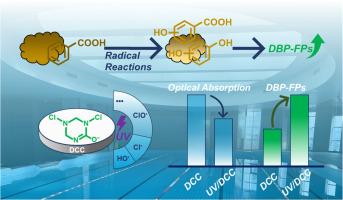Elucidating disinfection byproducts formation during UV/dichloroisocyanurate treatment of dissolved organic matter
IF 12.4
1区 环境科学与生态学
Q1 ENGINEERING, ENVIRONMENTAL
引用次数: 0
Abstract
Dissolved organic matter (DOM) is both a major sink for radicals and the primary precursor of disinfection by-products (DBPs) in advanced oxidation processes (AOPs). Here, we elucidate how UV activation of sodium dichloroisocyanurate (UV/DCC), a prevailing alternative disinfectant reshapes DOM chemistry and DBP formation in comparison with direct DCC chlorination. UV/DCC degraded significantly more DOM chromophores than DCC alone, yet produced more chlorinated organic products with shorter carbon skeletons and higher H/C ratios than DCC treatment produced. Correspondingly, total halogenated DBP yields increased by 44−181 % under UV/DCC. Operating conditions (UV fluence, pH, DCC dose) modulated the trade-off, with lower pH, lower dose, and extended irradiation mitigating DBP formation. Mechanistic evidence indicates that UV-generated hydroxyl radicals converted inert aromatic carboxylates into chlorination-prone phenolic compounds, explaining the surge in DBP formation. Overall, coupling UV with DCC fundamentally alters DOM transformation pathways and magnifies chlorinated DBP risks, highlighting the need for cautious evaluation of UV/DCC in micropollutant treatment applications (e.g., swimming pools and drinking water).

阐明紫外/二氯异氰脲酸盐处理溶解有机物过程中消毒副产物的形成
溶解有机物(DOM)是高级氧化过程(AOPs)中自由基的主要汇,也是消毒副产物(DBPs)的主要前体。在这里,我们阐明了二氯异氰尿酸钠(UV/DCC)是一种流行的替代消毒剂,与直接DCC氯化相比,紫外线活化如何重塑DOM化学和DBP的形成。与DCC处理相比,UV/DCC处理对DOM发色团的降解量显著增加,但产生的氯化有机产物碳骨架更短,H/C比更高。相应的,在UV/DCC下,总卤化DBP的产量增加了44 ~ 181%。操作条件(紫外线通量、pH值、DCC剂量)调节了权衡,较低的pH值、较低的剂量和较长的照射可减轻DBP的形成。机理证据表明,紫外线产生的羟基自由基将惰性芳香羧酸转化为氯化倾向的酚类化合物,解释了DBP形成的激增。总体而言,UV与DCC的耦合从根本上改变了DOM的转化途径,并放大了氯化DBP的风险,这突出了在微污染物处理应用(例如游泳池和饮用水)中对UV/DCC进行谨慎评估的必要性。
本文章由计算机程序翻译,如有差异,请以英文原文为准。
求助全文
约1分钟内获得全文
求助全文
来源期刊

Water Research
环境科学-工程:环境
CiteScore
20.80
自引率
9.40%
发文量
1307
审稿时长
38 days
期刊介绍:
Water Research, along with its open access companion journal Water Research X, serves as a platform for publishing original research papers covering various aspects of the science and technology related to the anthropogenic water cycle, water quality, and its management worldwide. The audience targeted by the journal comprises biologists, chemical engineers, chemists, civil engineers, environmental engineers, limnologists, and microbiologists. The scope of the journal include:
•Treatment processes for water and wastewaters (municipal, agricultural, industrial, and on-site treatment), including resource recovery and residuals management;
•Urban hydrology including sewer systems, stormwater management, and green infrastructure;
•Drinking water treatment and distribution;
•Potable and non-potable water reuse;
•Sanitation, public health, and risk assessment;
•Anaerobic digestion, solid and hazardous waste management, including source characterization and the effects and control of leachates and gaseous emissions;
•Contaminants (chemical, microbial, anthropogenic particles such as nanoparticles or microplastics) and related water quality sensing, monitoring, fate, and assessment;
•Anthropogenic impacts on inland, tidal, coastal and urban waters, focusing on surface and ground waters, and point and non-point sources of pollution;
•Environmental restoration, linked to surface water, groundwater and groundwater remediation;
•Analysis of the interfaces between sediments and water, and between water and atmosphere, focusing specifically on anthropogenic impacts;
•Mathematical modelling, systems analysis, machine learning, and beneficial use of big data related to the anthropogenic water cycle;
•Socio-economic, policy, and regulations studies.
 求助内容:
求助内容: 应助结果提醒方式:
应助结果提醒方式:


